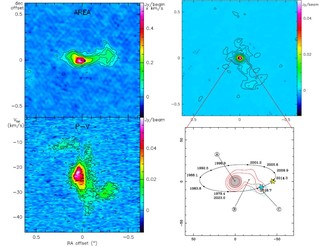
The international team led by Valentin Bujarrabal (Observatorio Astronomico National, Spain) and including Joanna Mikolajewska (CAMK) have for the first time directly imaged the strong gravitational effects of the white dwarf secondary on the circumstellar wind leaving the AGB primary, including strong confinement to the equatorial plane and the formation of a double spiral. Details in the original paper “High-resolution observations of the symbiotic system R Aqr. Direct imaging of the gravitational effects of the secondary on the stellar wind”.
The high-quality ALMA maps of the molecular CO lines and the continuum distributions (see the picture) probe the circumstellar regions in Aqr at suborbital scales. The CO maps (left panel) reveal strong focusing in the equatorial plane of the primary wind, which shows two plumes in the opposite directions and with different velocities that probably correspond to the expected double spiral due to the interaction with the companion. Continuum maps (right top panel) show the very inner region of the nascent bipolar jets, at a scales of some AU. The continuum maps obtained with the highest resolution (right bottom panel) show the presence of a clump that very probably corresponds to the emission from the white dwarf and its ionized surroundings and a bridge of material joining both stars, likely the stream of material flowing from the Mira to the accretion disk around the white dwarf. The relative position of the Mira and the companion is consistent with the known orbit of R Aqr (also shown in the picture), and the observation would be the first detection of mass transfer between the stars in a symbiotic system.






